In brief
In our report ‘The Moment We Noticed: Learning from 100 days of lockdown’, we invite you to join us in exploring how we might sustain the positives from the pandemic. This paper forms the backbone of our fourth invitation: to join us in developing the framework for relationships to thrive. Mutual aid and widespread community engagement has flourished since the start of lockdown. The state doesn’t own this new activity, but it can help it to thrive. In this paper, Tony Clements proposes 10 ways in which local authorities can help develop this framework and poses a series of questions to kickstart the discussion.Tony Clements
Tony has held senior positions at Newham and Ealing Councils, and is currently Strategic Director for Economy at Hammersmith and Fulham Council. He has previously worked as an expert advisor to Local Government and Housing Ministers. Tony is writing here in a personal and voluntary capacity.
This paper has benefited from discussions with Ray Shostak and David Robinson. Ray was head of the Prime Minister’s Delivery Unit, Director General of Performance Management and a member of the board of HM Treasury. He previously held several senior positions over many years in local government. David co-leads the Relationships Project.

In “The Moment We Noticed”, The Relationships Observatory reports on its observations from “100 days of behaving differently.” It describes how re-neighbouring, mutual aid and cross sector collaborations have characterized the local response in many communities across the UK.
Local government is the best placed public institution to help sustain and grow these currents.
The extent to which it includes energy and commitment to build independent community activity varies, however, from place to place. This is often as a result of competing priorities, the pressures of delivering statutory services, the constant effort to deliver a balanced budget, the stance of political administrations and senior leadership teams. Many local authorities who appreciate the power of stronger community relationships, are looking for new ways to enhance them with the tools and powers they have. Community activity has been at the heart of the work of councils during the Covid crisis. This has been most effective in those areas where there was already a strong focus on building independent community relationships. However virtually all councils have reported that the role of community groups has been significant or very significant in the local response.Local authorities put the strengthening of communities at the heart of their mission. This takes many forms: the delivery of services, economic development, place shaping.
What prompts, nudges and pressure could be applied to support the nurturing of these attitudes and behaviours into the future?So what could local government do to sustain the amalgam of attitudes and behaviours, the millions of social and moral choices individuals have made to enrich their communities?
1. Shift the obstacles
Councils can take an enabling and proportionate approach to the commonly cited examples that get in the way of community activity. These are duties that Councils hold but can be exercised with discretion, e.g:- GDPR: Sharing data and information and not using GDPR as a barrier in community projects
- DBS: Proportionate requirements around DBS checks
- Public space: Permissive use of public space, e.g. community road closures, use of green space, public buildings.
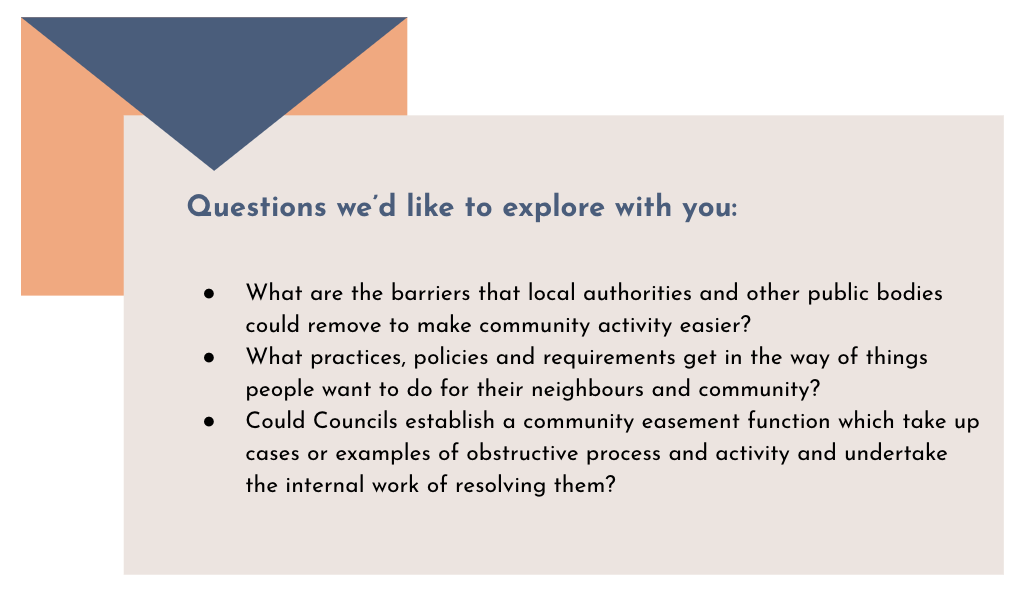
2. Develop new duties
We could introduce new duties and requirements to put strengthening communities on a par with other statutory duties such as financial, legal and safeguarding. For example:- Duty to support: Establish a duty to support, foster and strengthen community and neighbourly relationships and designate one chief officer to lead and be accountable for this.
- Annual reporting: Introduce a Requirement to publish annually a report of the health and vitality of local community activity and neighbourliness, and what the council and others can do to foster this.
- New legislation: Introduce a ‘Community Power of Competence’. Legislation in 2011 introduced a ‘General Power of Competence’, giving councils the ability to do anything, as long as it was not proscribed in law. A Community Power of Competence could provide the right for people to use public space, resources, undertake their own activities, unless councils can reasonably demonstrate why they shouldn’t. For example, if you wanted to close your road to hold a street party, you would inform the council and your neighbours and go ahead. At present you apply and pay for permission from the local authority.
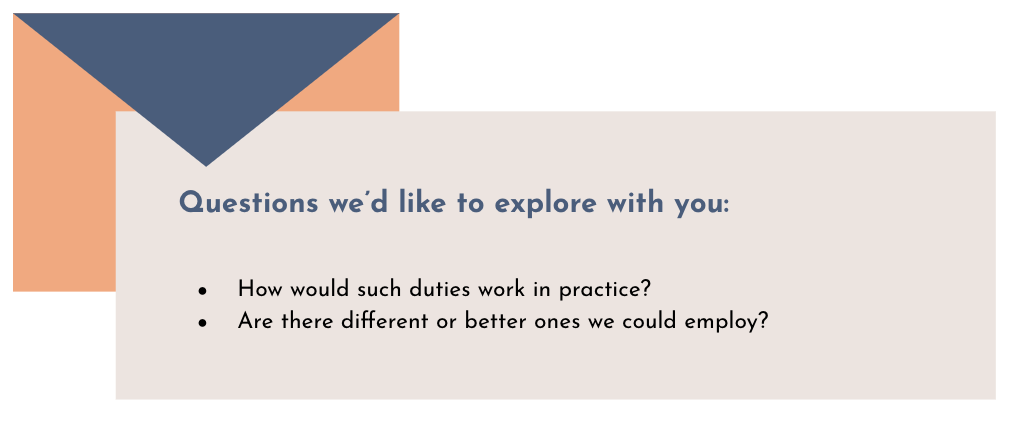
3. Focus on the relationship between councils and people
It may not be evident to many people undertaking new neighbourly activity of this kind that the council should have anything to do with it. Indeed, much local community activity emerges in response to things that councils do or things they neglect. For the Council to be a credible actor in this arena outside a crisis, it needs legitimacy and trust. Some of the ways to build trust, may also facilitate community and civic activity and be part of the ecosystem. Principles might include:- Service delivery: Transparent service delivery standards and honesty. Without decent core services and honesty when they fall short, councils will have a harder job convincing residents that its interventions, in a more sophisticated domain, are worthwhile.
- Decision-making: Transparency and openness in decision-making. Councils often make decisions and then ‘sell’ them to residents as the best solution. Councils could engender more trust by being more open about the constraints and trade-offs when making decisions. Letting citizens into the thought process allows more meaningful engagement for those that want it. It also leaves more space for co-creation and community action where citizens have different ideas or see other opportunities.
- Data: Open access to data. Make all council data routinely publicly available, unless there are reasons to hold it back – an open online platform which doesn’t rely on ‘requests’ or Freedom of Information. This would aid transparency, which can build trust, and provides an opportunity for people in the community to use that data for different purposes (e.g. City Mapper uses real-time TfL data that is publicly available)
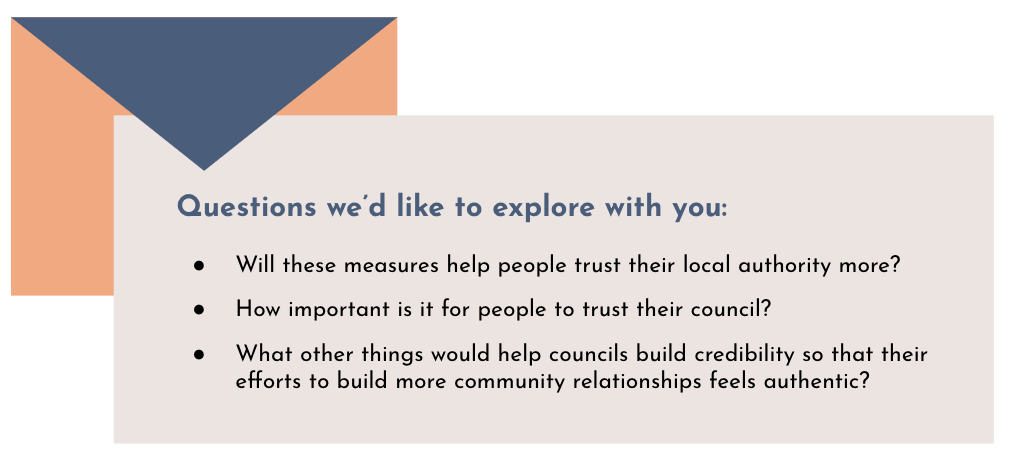
4. Train and develop council staff in new approaches to communities
One way of supporting community activity is through training members of the community in what and how to do new things. However, there is a lack of training and knowledge within councils in successfully fostering better community and neighbourhood relationships. There is often also a lack of visibility in how the unintended effects of public sector actions can support or inhibit community activity. This can be tackled by:- Management teams: Strengthening or introducing community development or neighbourhood management teams. These services were often the first casualty of austerity.
- Training: Implementing community development-type training for other front line staff to integrate a relationship building approach into ‘core business’ – housing management staff, safer communities officers, parks and leisure centre staff etc.
- Mentoring: Trialling reverse mentoring of senior management where they are paired with willing members of the community. This could be a valuable tool to reveal some of their blind spots and the unintended effects.
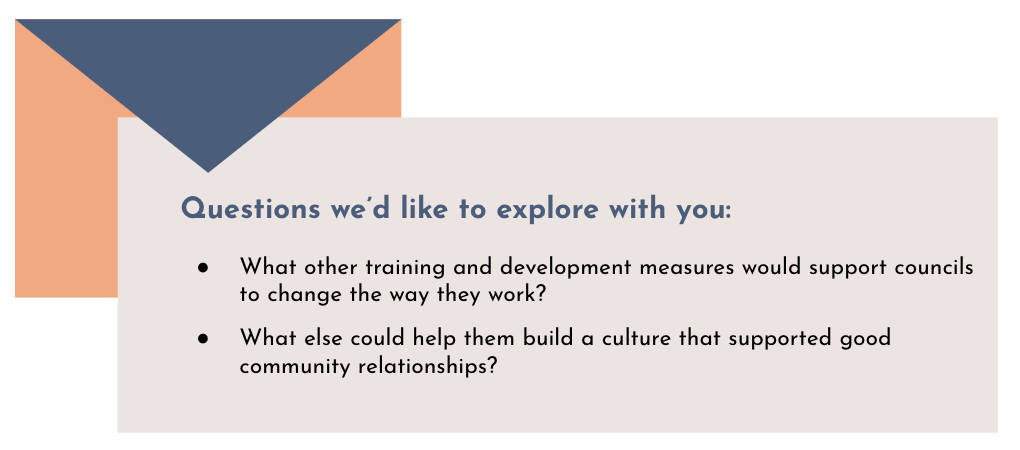
5. Utilise the everyday touch points
Almost everything a council does touches on the relationships within communities, not just those parts of the organisation with a ‘community’ label. This can be positive, negative or neutral.After Covid, when we have seen the power of neighbourly relationships, councils could make the building of better community relationships the task of every service. This will often be a better way of delivering those services anyway.This requires both drive and courage at a leadership level and trust in the creativity and judgement of front line staff in how they do their jobs. Indeed, it requires the public sector to embrace all the broader currents and shifts that The Observatory has identified. This could take almost unlimited forms across the vast range of services that councils deliver. Examples could include:
- Libraries, parks, community centres: These assets could be transformed by thinking of them as places of relationship building, not property or services. Councils could stop assessing their quality by the number of books issued, the state of the planting, the income generated, or the number of anti-social behaviour cases, but by the number of groups using them, the new initiatives started, how full they are round the clock. If, in a day, a library hosts a video games club, a community film night, provides quiet space for study and a chair aerobics class for older people, does it matter if no-one borrows a book? We can re-skill our librarians, caretakers and grounds staff as professional community connectors as they stack the shelves, open the halls and do the planting.
- Community safety: Neighbour disputes (for example noise or mess) are the most frequent anti-social behaviour complaints. They are also some of the hardest to resolve through enforcement, rarely leading to a satisfactory outcome, always requiring a lot of effort, paperwork and evidence gathering. Councils could respond to complaints more quickly with trained mediators to help resolve issues and build relationships instead of enforcement officers seeking, often in vain, legal remedies.
- Employment and skills: Most people find jobs through people they know. Rather than a narrow focus on skills training for those out of work, councils could proactively build local, professional networks for those who don’t have them and connect them to people working in areas where they are interested. Skills and qualifications can come next to support progression.
- Homelessness: Individuals turn up at housing services, but the reasons that bring them there often involve their family relationships, and the assumption by families that councils can provide more and better housing for people than they do. Rather than just dealing with an individual’s eligibility criteria in the system, housing officers can visit families with the applicant to discuss options together, explain the realities of temporary accommodation and support people in their existing accommodation. This can include financial incentives or the establishment of a formal tenancy.
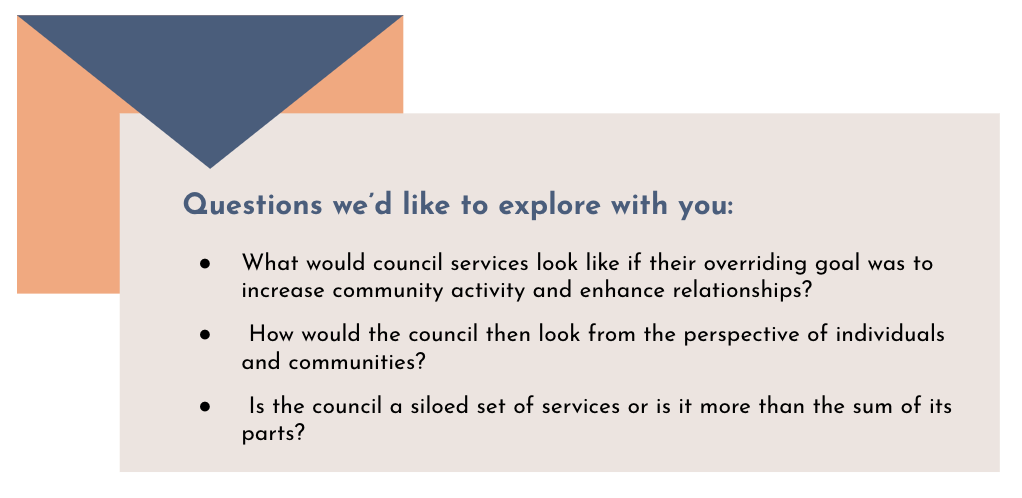
6. Build relationships into the physical environment
Through the planning system, through delivering housing, in regeneration schemes, through to the provision of benches and green space, and highway design, councils shape the long-term physical environments of their areas. We all know that some places feel naturally comfortable to linger, chat to neighbours and strike up conversations with those we don’t know. We all know parts of our neighbourhood, where we hurry past others because it’s noisy, there’s too much traffic, it doesn’t feel safe. Or where our private space feels intruded upon, so we feel the need to put up barriers physically and socially. Councils can put the ‘bumping into’ spaces at the heart of their physical infrastructure by:- Community involvement: Involving the community in the design of those spaces, so they are ‘owned’ from the outset
- Expertise: Using the best professional advice
- Access: Limiting the private ownership of public space. If the only pleasant places to stop are cafes and restaurants, it excludes those on lower incomes.
If property owners’ rules prohibit games or cycling it sends messages about who is welcome. We need a right to loiter.
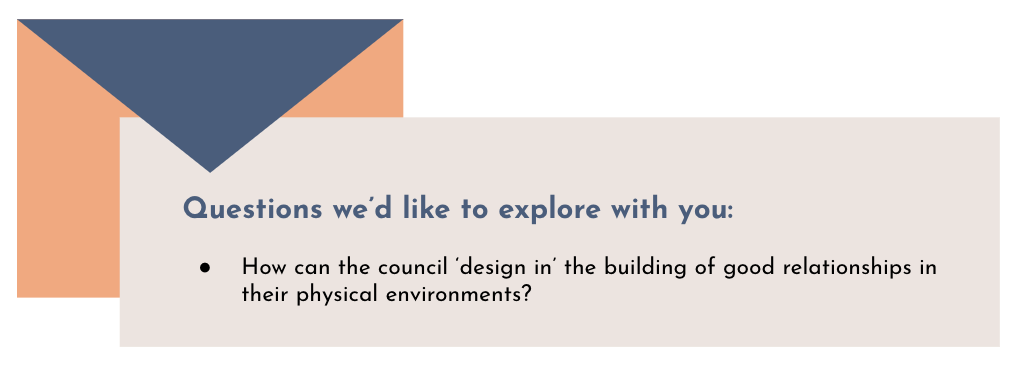
7. Sustain motivation and build new purpose
The crisis has given people both time and a motivation to support their neighbours. The crisis is universal and visible. There are other crises (and opportunities for community activity) that are not visible to the general public but are to councils. Councils could choose to share the problems and issues facing communities more transparently and invite community action: isolated older people nearby, children in over-crowded homes, environmental crime, underused and difficult to manage spaces. Councils would be able to do this on the hyper-local level that is a feature of the Covid activism. One of the features of the Covid response is that people see their neighbourly actions as part of a national or indeed global effort to tackle the effects of the pandemic.Councils could show more clearly the link between reducing the isolation of older people in the community and fewer hospital admissions, more money kept by the NHS for others or fewer social care requirements, so more available to spend on parks, libraries, leisure centres. This is not about trying to make people quasi-social workers, but show that the everyday contact they have with their friends and neighbours makes a societal as well as an individual difference. As a result of this conversation neighbours and statutory services might then, for example, work together on developing social care huddles or circles to keep people happy and safe in their own community.People routinely underestimate the power and impact of their neighbourly efforts in normal times. We could do more to mobilise people who are motivated by a sense of being part of a bigger mission.
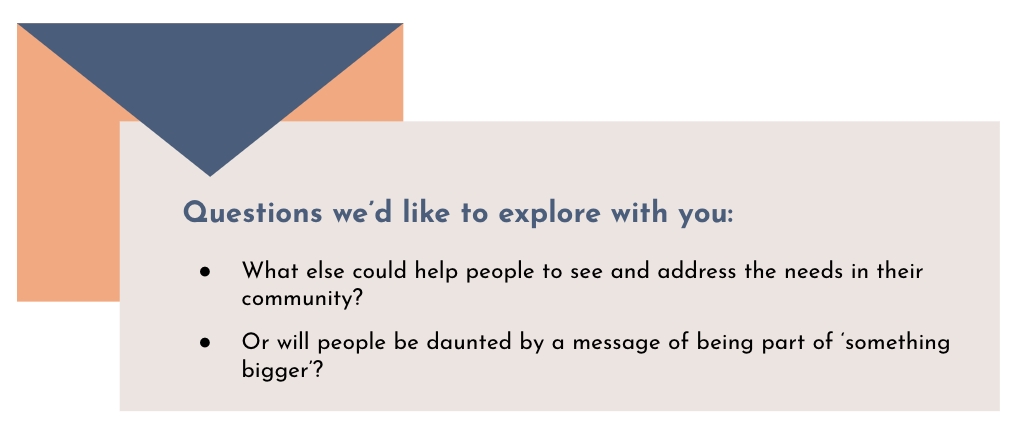
8. Fostering the ecosystem
Where do we go next with the relationships that have developed during lockdown?- Sustain the community hubs: The most effective community hubs during the Covid crisis are in those authorities where there are existing good relationships and structures. However they have been effective in most places and opened the eyes of some councils where community activity has been less central to their strategy. Councils could be required to sustain their community hubs, continue to do the activity they currently do where relevant and evolve to meet other needs over time. Councils could consider if other services could be best delivered from the hubs with partners, such as social care, public health, employment support.
- Retain the community roles: Many council staff have been redeployed to work on the community response to Covid. Has their community role had more impact than what they would have done in their substantive roles? Councils could commit to this redeployment for a further year; see what gaps emerge in their service provision and what value comes from working more directly with the community?
- Convene neighbourhood assemblies: The stories that communities and organisations create from this period will be important. It is likely to be remembered as a period of difficulty by many and an understanding of the new social relationships in an area may or may not come to the fore in stories around employment, losing income, loss of schooling etc. Councils could use their convening ability to facilitate neighbourhood level forums which allow communities to reflect on this time and consider what in their community they thought was valuable about this time and the activity and relationships they’d like to continue. They might use the Relationships Project Story Book tool. This would be an overt attempt to transition more community activity into ‘normal’ post-covid life and help people reflect on and appreciate that their small scale community actions have been part of something powerful.What are the right ways to do this that go beyond the limitations of traditional public meetings?
- Run or support Community Connector training: Councils could seek to increase the numbers of those doing neighbourly activity and increase the impact of those who do. One model is through Community Connector training along the Frome model, where over 1000 people have undertaken light-touch training (2 hour session) to help signpost friends and neighbours to services and organisations that they might need. Similar examples include Newham’s Health Champions, people in the community, equipped with some training to support the health and well-being of those around them. Barking and Dagenham’s Citizen’s Alliance Network is being set-up specifically to ‘continue the coming together of our borough’ that they have experienced during lock down. This could start with those engaged in the community hubs.
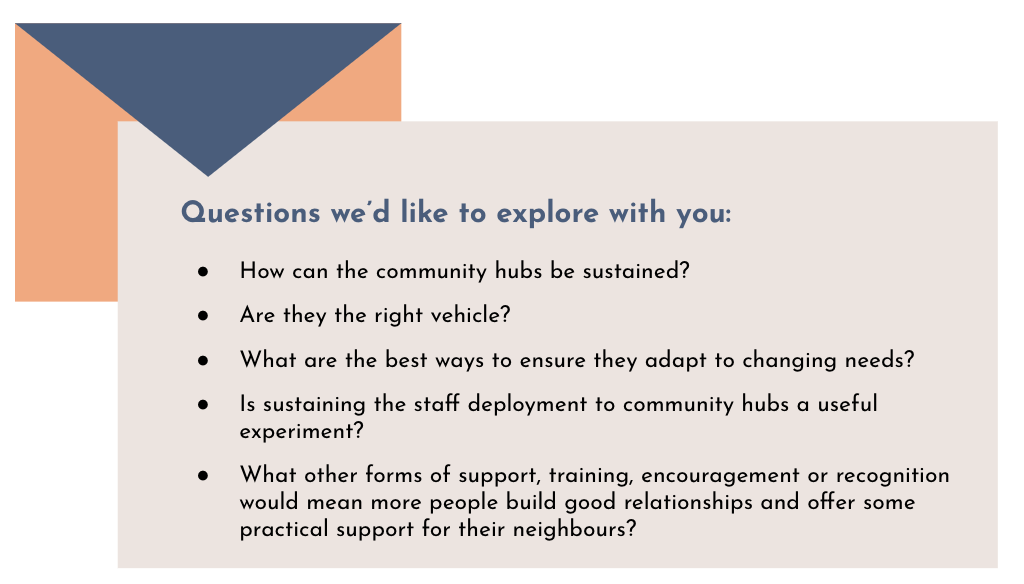
9. Renew the relationship with the voluntary sector
Most community hubs have been cross-sector, with anchor organisations, specialist charities, faith groups as well as volunteers and more informal groups. The most successful local efforts have been in places where there was already a history of working well together. The heart of this was the good interpersonal relationships rather than formal partnership structures. One of the characteristics of these collaborations has been that leadership has been shared between councils and the voluntary sector. In the crisis, many places have gone beyond the hierarchical relationship between council and voluntary sector.Councils and the voluntary sector should continue to find ways to share leadership within the communities they work. Many of the same features of shared leadership apply outside of the Covid crisis. Rarely do the problems people face fit neatly into the responsibilities of ‘sectors’ or ‘services’. There is always more than enough for everyone do to and competition between organisations is a waste of effort and energy.The position of the voluntary sector as applicant or supplicant to the public sector was superseded. This is because in the crisis no-one could fix or do everything, nor indeed is it clear where the responsibility for many needs definitively lay. Leadership fell to those most able or willing to adopt it, sometimes the council, sometimes the voluntary sector, and with little competition or defensiveness.
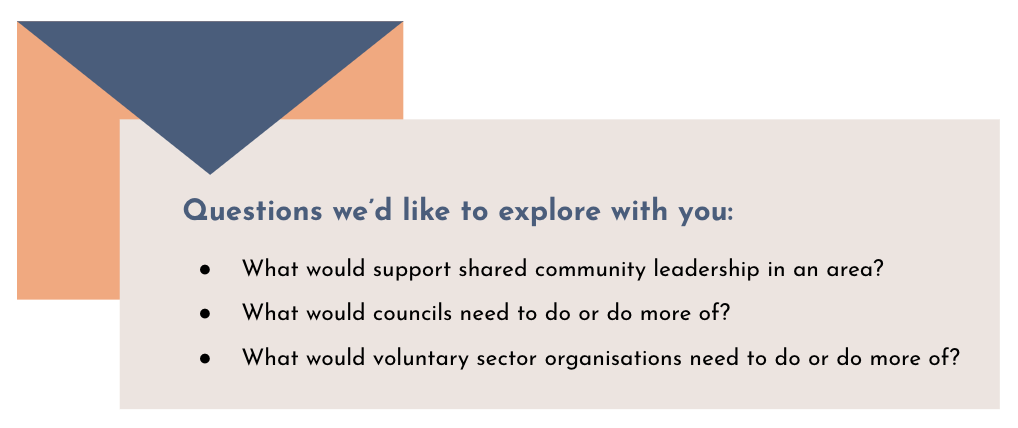
10. Review purchasing and procurement
The shared leadership between the public sector and voluntary sector is in part a rebalancing of a power relationship. It is also part of the current towards greater trust. This could be enhanced and cemented in the ways councils (and indeed the NHS and other public services) use their purchasing power and procure services. During the crisis, procurement of local services and the use of public money was more flexible to quickly mobilise the local organisations who could deliver.Continuing with this new approach after the crisis would support the development of the local community economy. The Social Value Act was intended to support this objective but tended towards adding social benefits to the usual contractors. Freer procurement strategies would be transformational.Procurement rules make it difficult for smaller community and third sector organisations to bid and win public sector contracts. Spending budgets on local community providers of services – from care to parks to catering keeps money in the local economy, means less is extracted as profit and strengthens the capacity and capability of community organisations.
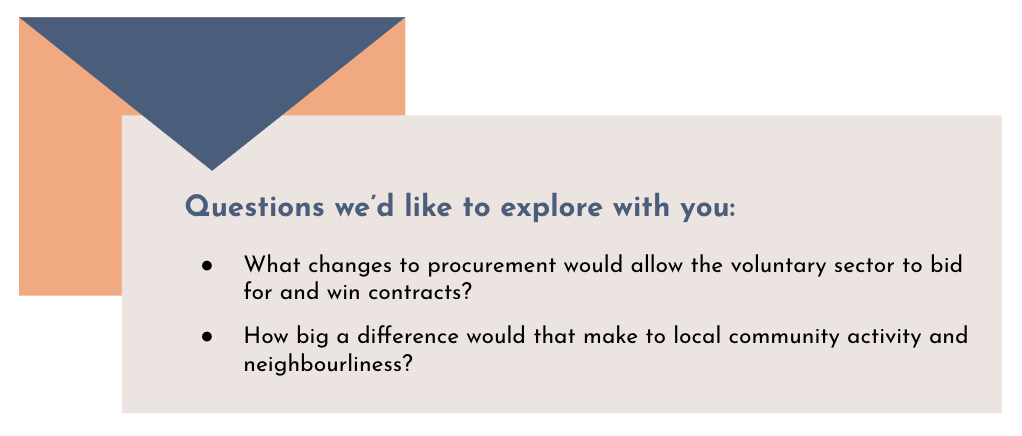
Follow up
Since writing this paper, Tony has written a follow-up blog in which he reflects on the subsequent discussion we hosted and the idea that modest cultural change within councils can have on mobilising communities.

Trackbacks/Pingbacks